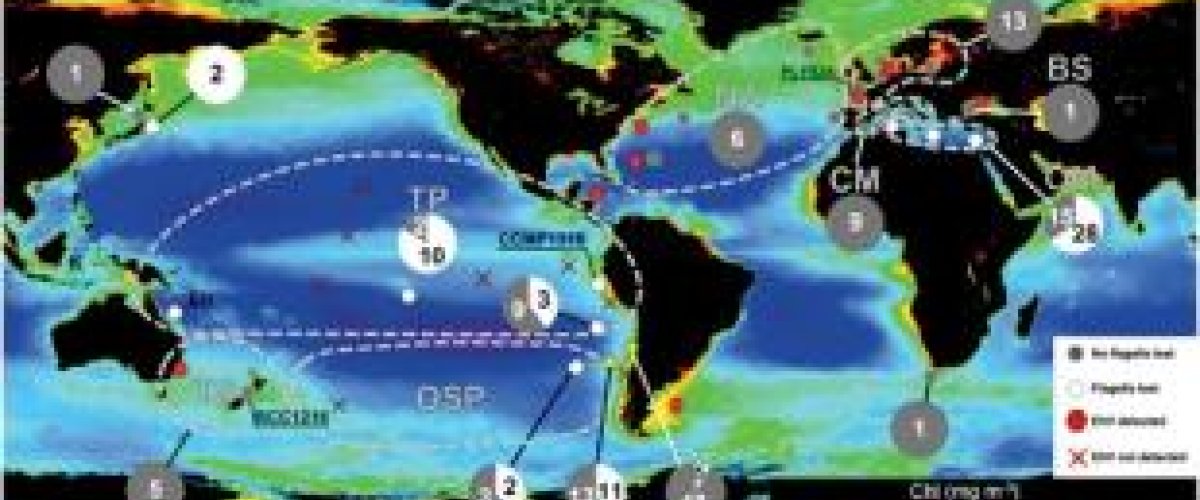“Sex on the beach, but not in the open ocean”
One of the biggest questions in biology is why do organisms have sex. Sex has a high energy cost and can disrupt good gene combinations, so why do it? A related question is why do organisms have life cycles, changing from one form to another. Why not just stick with the best form?
In a paper published last week by a team lead by Dr. von Dassow, they show that viruses and dynamic environments are required to maintain a full life cycle, and apparently sex as well, in one organism. They studied the unicellular ocean alga called Emiliania huxleyi. It is the most common of the class of unicellular algae called coccolithophores. Some scientists have suspected that these organisms, which are very important to global carbon cycles because they produce calcium carbonate shells, might be threatened by the increase in acidity as the ocean absorbs carbon dioxide. Dr. von Dassow and his colleagues wanted to study how Emiliania has been adapting to very different environments.
What they found surprised them. The species alternates between a diploid phase that carries two versions of the genome (as do many other organisms, like animals and higher plants) and a haploid phase that carries only one genome. Even though it is only as old as the human species, it has a very variable genome. Von Dassow and co-workers found that many individual Emiliania appear to have lost the genes necessary for completing the life cycle, appearing stuck in just the diploid phase. Specifically, these Emiliania lost the genes for making flagella, the structure that allows cells to swim, whether haploid Emiliania or animal sperm. Von Dassow says “it’s hard to prove 100% that they never have sex if the haploid cells can’t swim, but their genome structure looks that way.” When an organism reproduces sexually, two versions of the genome are re-combined in a process called meiosis. This mixes variability between the two versions. In the Emiliania that have lost the ability to swim, the two genome versions are seen drifting apart with structures that are so different they might not be able to recombine, suggesting they are never mixing by meiosis. Emiliania that keep the ability to form swimming haploid cells don’t show this effect.
These authors found that Emiliania never lost the ability to make swimming cells (never lost sex) in ocean environments where it is attacked by a deadly virus. One of the explanations for why organisms have sex has long been the pressure from viruses and other enemies, with whom they are in an evolutionary arms race. The hosts must evolve as fast as they can to keep up with parasites and viruses that are always evolving to be better at infecting them, and the recombination of genes in sex helps the hosts do this. This is named the Red Queen Hypothesis, from the book Alice in Wonderland where the Alice and the Red Queen run as fast as they can just to stay in place. But the situation might be even simpler. In the book, the Red Queen could never cut off the head of the Cheshire Cat, because he could make his body disappear. Likewise, the viruses that attack Emiliania only attack the diploid phase. Like the Cheshire Cat, Emiliania can escape, by becoming haploid cells which are invisible to the viruses. The virus can only occur when Emiliania regularly reaches dense populations. The virus doesn’t seem to be present where Emiliania maintain steady low density populations, and in those regions Emiliania starts to lose the haploid phase. That suggests the presence of parasites and viruses in dense populations might directly drive life cycles and sex.
This article was published by a team led by Dr. Peter Von Dassow, research associate at the UMI 3614 and professor at the Pontifical Catholic University of Chile. The research team included scientists from Chile, Japan, Germany, England, America and France, particularly three groups of the Biological Station of Roscoff, and was based especially in the culture collection of Roscoff (Roscoff Culture Collection; RCC)
References:
von Dassow P, John U, Ogata H, Probert I, Bendif EM, Kegel JU, Audic S, Wincker P, Da Silva C, Claverie JM, Doney S, Glover DM, Mella-Flores D, Herrera Y, Lescot M, Garet-Delmas MJ & de Vargas C. 2014. Life-cycle modification in open oceans accounts for genome variability in a cosmopolitan phytoplankton. The ISME Journal 1–13. doi:10.1038/ismej.2014.221.
M. Frada, I. Probert, M.J. Allen, W. H. Wilson, and Colomban de Vargas (2008). The “Cheshire Cat” escape strategy of the coccolithophore Emiliania huxleyi in response to viral infection. PNAS, 105 (41) 15944–15949
Legend of figure:
Biogeographic distribution asexuality in E. huxleyi. Strain origins, presence/absence of cDHC and inner arm DHC1β in strain genomes, and epipelagic metagenome data sets examined for detection/lack of EhV sequences. All RCC strains tested are mapped onto the plot of MODIS Aqua satellite Chl-a 2002–2011 mission average. In addition to pelagic metagenome data sets, EhV results from a sediment metagenome from the Peru continental margin and the PCR-based study of Black Sea sediments (Coolen, 2011) are also shown.








